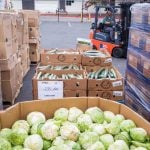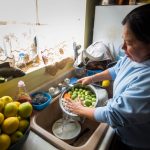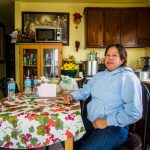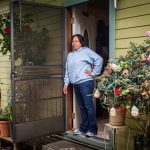Elisa had never heard of free food. That’s not why she came to America with her two young boys, age ten and twelve, from Jalisco, Mexico. She heard about jobs and opportunities for her children to be educated and move up in life. So she came into the country and made her way to the central California town of Santa Barbara.
Elisa is a strong woman – no one who isn’t could survive her journey into this country. But she is a very quiet, shy woman. She had family to stay with in the small, bedroom community of Isla Vista, CA for a short time, but she soon found a job cleaning a house in a wealthy neighborhood of Santa Barbara so she moved her children into an apartment. This was the first time she’d ever had to pay rent. Back in Jalisco, she’d lived in a family house that they owned. She was making some money here, but America can be expensive.
A friend at church told her about the monthly food bank distribution option. Bundles of produce, canned goods, dry products and dairy were distributed at the church. She said, “Gracias a Dios,” and she stretched it over a month to feed her family and save money for bills.
Old Town Goleta is a tight-knit community, mostly of Latino descent. The small, affordable homes and old apartments cluster within striking distance of the area’s jobs – agriculture to the north and service jobs in homes and hospitality to the south.
Like any small town, word spreads fast here, which can be good or bad. On the bad side, there’s a local sense that Immigration and Customs Enforcement (ICE) is always lurking, and the wrong kind of word can get you or a family-member deported. So there’s mistrust and fear, especially around signing up for government programs. But there are advantages to a tight-knit, word-of-mouth community and the ground-level, extended-family-to-extended-family communication element can be a powerful tool to incite communities to organize around healthy food.
Amy Lopez works as Outreach Manager for the Food Bank of Santa Barbara (FBSB). Amy is Latina but she’s not from the heart of the Old Town Goleta community. She’s a coordinator of Healthy School Pantry and oversees the CalFresh (California’s name for the SNAP nutrition assistance program) outreach program at the FoodBank. The Healthy School Pantry is an award-winning food bank program that thinks outside the typical food bank box. But even the best programs can be meaningless if no one in the community knows about it or, just as common in an immigrant community besieged by ICE, trusts it. So community voices like Elisa’s matter.
The Santa Barbara Food Bank does not follow a traditional model. Many food banks in the US operate primarily as an emergency resource.
“It’s a one-way street,” says Erik Talkin, Santa Barbara Food Bank executive director. “Nobody’s life changes by standing in the sun for a few hours to get food. We want to help people make their own changes.”
The Healthy School Pantry is not rocket science but it is innovative. The fundamental difference is its all-inclusive nature, open not just to “the needy,” but to the entire school community of students, teachers and parents. The Healthy School Pantry takes advantage of an existing community space, the after-school setting, to be the gathering point. In this space, the pantry acts more as a celebratory fair than a demoralizing line that places a stark label on the “haves” and “have-nots.”

Talkin and his staff at the FBSB identify schools in low-income areas with high frequency of reduced or free lunch/breakfast. They introduce the school pantry idea to the school administration and gauge energy and willingness to support it. The actual Healthy School Pantry, when implemented, is a sort of walking cooking demo with a recipe of the day being offered for tasting. It’s part of FBSB’s “food literacy” program that teaches about food and nutrition through experiential methods that walk in step with people’s daily lives. Participants make their way through the various demonstration and nutrition awareness booths, gathering stamps that can be redeemed at the end for healthy food bank products, plus ingredients necessary to cook the recipe. It’s fun, educational and nutritious, and it achieves the same result as a food line – clients receive food to take home – yet with a better understanding of how to prepare the food, and without the stigma associated with traditional food bank handouts.
It worked for Elisa. Early on, she struggled with joining her new community. Amy Lopez remembers seeing Elisa at the Old Goleta Community Center pick-up spot. She observed Elisa at the distribution point and then later spotted her at the Healthy School Pantry. She saw in Elisa a very shy woman trying to integrate into her new community.
Amy eventually approached Elisa and asked her to be part of the Nutrition Advocacy Network, a unique program of FBSB that makes volunteers and clients like Elisa the voice of their communities. As a nutrition advocate, Elisa would listen to her neighbors and provide FBSB with valuable input about food needs for the pantry or relevant topics for nutrition classes. Elisa agreed but remained in the background, just handing out the food. Eventually Amy helped Elisa learn to register community members for HSP and discuss with them the benefits of CalFresh despite the fact that Elisa, at the time, could not read or write.
Now Elisa is the lead advocate in her group of seven. She helps register new folks at the monthly Healthy School Pantry gatherings.
“She helps me promote CalFresh to families in the neighborhood,” Amy says. “She’s a voice in Old Town Goleta. She promotes it everywhere, just through word-of-mouth. That’s how trust and community grow.”







